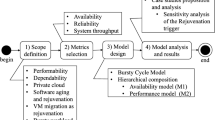Abstract
Demands on software reliability and availability have increased tremendously due to the nature of present day applications. We focus on the aspect of software for the high availability of application servers since the unavailability of servers more often originates from software faults rather than hardware faults. The software rejuvenation technique has been widely used to avoid the occurrence of unplanned failures, mainly due to the phenomena of software aging or caused by transient failures. In this paper, first we present a new way of using the virtual machine based software rejuvenation named VMSR to offer high availability for application server systems. Second we model a single physical server which is used to host multiple virtual machines (VMs) with the VMSR framework using stochastic modeling and evaluate it through both numerical analysis and SHARPE (Symbolic Hierarchical Automated Reliability and Performance Evaluator) tool simulation. This VMSR model is very general and can capture application server characteristics, failure behavior, and performability measures. Our results demonstrate that VMSR approach is a practical way to ensure uninterrupted availability and to optimize performance for aging applications.
Similar content being viewed by others
Explore related subjects
Discover the latest articles and news from researchers in related subjects, suggested using machine learning.References
Gray J, Siewiorek D P. High-availability computer systems. IEEE Computer, 1991, 24(9): 39–48.
Sullivan M, Chillarege R. Software defects and their impact on system availability — A study of field failures in operating systems. In Proc. the 21st Int. Symp., Fault-Tolerant Computing, Montreal, Canada, June 25–27, 1991, pp.2–9.
Grottke M, Li L, Vaidyanathan K, Trivedi K S. Analysis of software aging in a Web server. IEEE Transactions on Reliability, 2006, 55(3): 411–420.
Software rejuvenation. Department of Electrical and Computer Engineering, Duke University, http://www.software-rejuvenation.com/.
Huang Y, Kintala C, Kolettis N, Fulton N D. Software rejuvenation: Analysis, module and application. In Proc. the 25th Int. Symp., Fault-Tolerant Computing, Pasadena, CA, June 27–30, 1995, pp.381–390.
Nanda S, Chiueh T. A survey on virtualization technologies. Tech. Rep. TR-179, Stony Brook University, Feb. 2005.
Trivedi K S, Vaidyanathan K, Goseva-Popstojanova K. Modeling and analysis of software aging and rejuvenation. In Proc. the 33rd Annual Simulation Symp., Greece, Apr. 2000, pp.270–279.
Castelli V, Harper R E, Heidelberger P, Hunter S W, Trivedi K S, Vaidyanathan K, Zeggert W P. Proactive management of software aging. IBM Journal of Research and Development, 2001, 45(2): 311–332.
Garg S, Moorsel A V, Vaidynathan K, Trivedi K S. A methodology for detection and estimation of software aging. In Proc. the 9th Int. Symp. Software Reliability Engineering, Paderborn, Germany, November 4–7, 1998, p.283.
Vaidyanathan K, Trivedi K S. A measurement-based model for estimation of software aging in operational software systems. In Proc. the 10th IEEE Int. Symp., Software Reliability Engineering, Boca Raton, FL, USA, Nov. 1–4, 1999, pp.88–93.
Barham B, Dragovic B, Fraser K, Hand S, Harris T, Ho A, Neugebauer R, Pratt I, Warfield A. Xen and the art of virtualization. In Proc. the 19th Int. ACM Symp. Operating Systems Principles, New York, USA, ACM Press, 2003, pp.164–177.
Begnum K M, Disney M. Scalable deployment and configuration of high-performance virtual clusters. International Journal of Applied Mathematics and Computer Sciences, 2005, ISSN 1307–6906, 2(4): 175–180.
Mergen M F, Uhlig V, Krieger O, Xenidis J. Virtualization for high-performance computing. SIGOPS Operating Systems Review, 2006, 40(1): 8–11.
Nagarajan A B, Mueller F, Engelmann C, Scott L S. Proactive fault tolerance for HPC with Xen virtualization. In Proc. the 21st Annual Int. Conference on Super Computing, Seattle, Washington, USA, June 17–21, 2007, pp.23–32.
Silva L M, Alonso J, Silva P, Torres J, Andrzejak A. Using virtualization to improve software rejuvenation. In Proc. the 6th IEEE Int. Symp. Network Computing and Applications, July 12–14, 2007, pp.33–44.
Kourai K, Chiba S. A fast rejuvenation technique for server consolidation with virtual machines. In Proc. the 37th Annual IEEE/IFIP Int. Conference on Dependable Systems and Networks (DSN’07), June 25–28, 2007, pp.245–255.
Alonso J, Silva L, Andrzejak A, Silva P, Torres J. Highavailable grid services through the use of virtualized clustering. In Proc. the 8th IEEE/ACM Int. Conference on Grid Computing, Austin, Texas, Sept. 19–21, 2007, pp.34–41.
Garg S, Puliafito A, Telek M, Trivedi K S. Analysis of preventive maintenance in transactions based software systems. IEEE Transactions on Computers, 1998, 47(1): 96–107.
Hirel C, Sahner R, Zang X, Trivedi K S. Reliability and performability modeling using SHARPE 2000. Computer Performance Evaluation/TOOLS 2000. Lecture Notes in Computer Science 1786, Springer-Verlag, 2000, pp.345–349.
Trivedi K S. SHARPE 2002: Symbolic hierarchical automated reliability and performance evaluator. In Proc. Int. Conference on Dependable Systems and Networks, 2002, p.544.
Author information
Authors and Affiliations
Corresponding author
Additional information
This research was supported by the Korea Research Foundation Grant funded by the Korean Government (MOEHRD) under Grant No. KRF2007-210-D00006.
Rights and permissions
About this article
Cite this article
Thein, T., Sou Park, J. Availability Analysis of Application Servers Using Software Rejuvenation and Virtualization. J. Comput. Sci. Technol. 24, 339–346 (2009). https://doi.org/10.1007/s11390-009-9228-1
Received:
Revised:
Published:
Issue Date:
DOI: https://doi.org/10.1007/s11390-009-9228-1




